
| Mobile Technology Services |
 |
| Written by Benjamin K. Eshun | ||||||||||||||||||
|
Mobile Technology is becoming widely accepted throughout the world. Both the number of subscribers and the cellular coverage areas are increasing continuously. In addition, more advanced digital cellular coverage is on the rise, allowing data and voice to be mixed seamlessly.
GPS Accuracy There are two transmission codes; the P code (Precision code) for military use, and the C/A code (Civilian Access code) for civilian use.
|
||||||||||||||||||
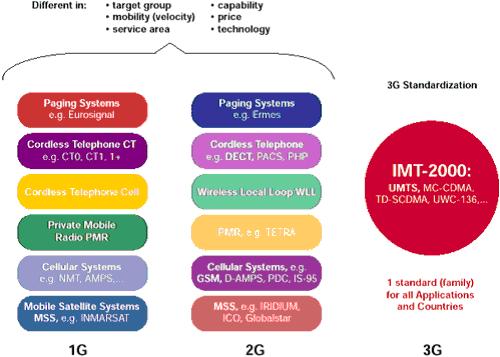 |
| Fig.2: Multiple Standards for Different Applications and Countries |
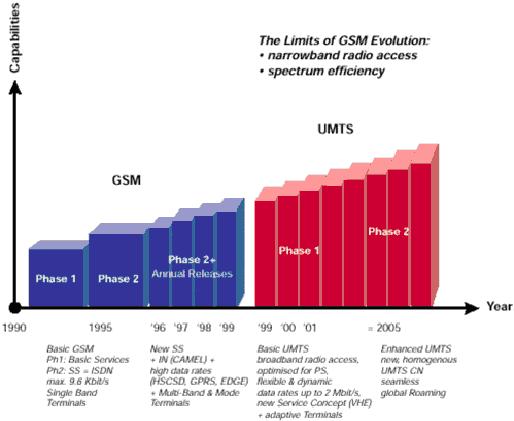 |
| Fig.3: Evolutionary Concept |
(II) The GSM Network
GSM provides recommendations, not requirements. The GSM specifications define the functions and interface requirements in detail but do not address the hardware. The reason for this is to limit the designers as few as possible but still to make it possible for the operators to buy equipment from different suppliers, to ensure flexible integrated service. The GSM network is divided into three major systems: the switching system (SS), the base station system (BSS), and the operation and support system (OSS). The basic GSM network elements are shown in Fig 4.
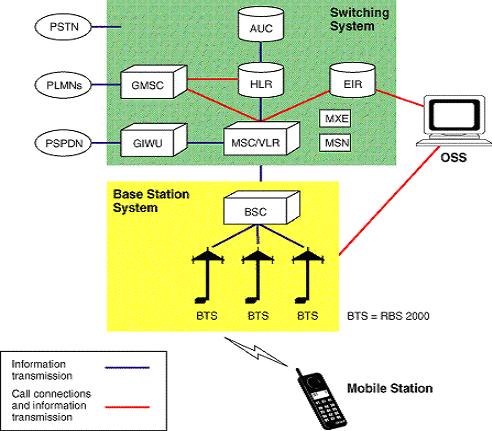 |
| Fig:4. GSM Network Elements |
The Switching System
The switching system (SS) is responsible for performing call processing and subscriber-related functions. The switching system includes the following functional units.
The Base Station System (BSS)
All radio-related functions are performed in the BSS, which consists of base station controllers (BSCs) and the base transceiver stations (BTSs).
The Operation and Support System
The operations and maintenance center (OMC) is connected to all equipment in the switching system and to the BSC. The implementation of OMC is called the operation and support system (OSS). The OSS is the functional entity from which the network operator monitors and controls the system. The purpose of OSS is to offer the customer cost-effective support for centralized, regional, and local operational and maintenance activities that are required for a GSM network. An important function of OSS is to provide a network overview and support the maintenance activities of different operation and maintenance organizations.
Additional Functional Elements
Other functional elements shown in Fig 4 are as follows:
GSM Network Areas
The GSM network is made up of geographic areas. As shown in Fig 5, these areas include cells, location areas (LAs), MSC/VLR service areas, and public land mobile network (PLMN) areas.
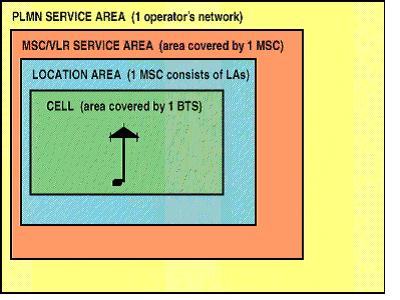 |
| Fig. 5: Network Areas |
The cell is the area given radio coverage by one base transceiver station. The GSM network identifies each cell via the cell global identity (CGI) number assigned to each cell. The location area is a group of cells. It is the area in which the subscriber is paged. Each LA is served by one or more base station controllers, yet only by a single MSC Fig 6). Each LA is assigned a location area identity (LAI) number.
 |
| Fig. 6: Location Areas |
An MSC/VLR service area represents the part of the GSM network that is covered by one MSC and which is reachable, as it is registered in the VLR of the MSC (see Fig. 7).
 |
| Fig. 7: MSC/VLR Service Areas |
The PLMN service area is an area served by one network operator.
(III) The UMTS Network
Universal Mobile Telecommunications System (UMTS) is envisioned as the successor to Global System for Mobile Communications (GSM). UMTS also addresses the growing demand of mobile and Internet applications for new capacity in the overcrowded mobile communications sky. The network increases transmission speed to 2 Mbps per mobile user and establishes a global roaming standard.
UMTS, also referred to as wideband code division multiple access (W-CDMA), is one of the most significant advances in the evolution of telecommunications into 3G networks. UMTS allows many more applications to be introduced to a worldwide base of users and provides a vital link between today's multiple GSM systems and the ultimate single worldwide standard for all mobile telecommunications, International Mobile Telecommunications-2000 (IMT-2000).
UMTS (Rel. '99) incorporates enhanced GSM Phase 2+ Core Networks (CN) with GPRS and CAMEL. This enables network operators to enjoy the improved cost-efficiency of UMTS while protecting their 2G investments and reducing the risks of implementation.
In UMTS release 1 (Rel. '99), a new radio access network UMTS terrestrial radio access network (UTRAN) is introduced. UTRAN, the UMTS radio access network (RAN), is connected via the Iu to the GSM Phase 2+ core network (CN). The Iu is the UTRAN interface between the radio network controller (RNC) and CN; the UTRAN interface between RNC and the packet-switched domain of the CN (Iu-PS) is used for PS data and the UTRAN interface between RNC and the circuit-switched domain of the CN (Iu-CS) is used for CS data.
"GSM-only" mobile stations (MSs) will be connected to the network via the GSM air (radio) interface (Um). UMTS/GSM dual-mode user equipment (UE) will be connected to the network via UMTS air (radio) interface (Uu) at very high data rates (up to almost 2 Mbps). Outside the UMTS service area, UMTS/GSM UE will be connected to the network at reduced data rates via the Um.
Maximum data rates are 115 kbps for CS data by HSCSD, 171 kbps for PS data by GPRS, and 553 kbps by EDGE. Handover between UMTS and GSM is supported, and handover between UMTS and other 3G systems (e.g., multicarrier CDMA [MC-CDMA]) will be supported to achieve true worldwide access.
GPRS - The most important evolutionary step of GSM toward UMTS is GPRS. GPRS introduces packet-switched (PS) into the GSM CN and allows direct access to packet data networks (PDNs). This enables high-data rate PS transmission well beyond the 64 kbps limit of ISDN through the GSM CN, a necessity for UMTS data transmission rates of up to 2 Mbps. GPRS prepares and optimizes the CN for high-data rate PS transmission, as does UMTS with UTRAN over the RAN. Thus, GPRS is a prerequisite for the UMTS introduction.
Two functional units extend the GSM NSS architecture for GPRS PS services: the GGSN and the SGSN. The GGSN has functions comparable to a gateway MSC (GMSC). The SGSN resides at the same hierarchical level as a visited MSC (VMSC)/VLR and therefore performs comparable functions such as routing and mobility management.
CAMEL - CAMEL enables worldwide access to operator-specific IN applications such as prepaid, call screening, and supervision. CAMEL is the primary GSM Phase 2+ enhancement for the introduction of the UMTS virtual home environment (VHE) concept. VHE is a platform for flexible service definition (collection of service creation tools) that enables the operator to modify or enhance existing services and/or define new services. Furthermore, VHE enables worldwide access to these operator-specific services in every GSM and UMTS PLMN and introduces location-based services (by interaction with GSM/UMTS mobility management). A CSE and a new common control signaling system 7 (SS7) (CCS7) protocol, the CAMEL application part (CAP), are required on the CN to introduce CAMEL.
(IV) Wireless Application Protocol (WAP)
This is an application environment and set of communication protocols for wireless devices designed to enable manufacturer-, vendor-, and technology-independent access to the Internet and advanced telephony services.
WAP bridges the gap between the mobile world and the Internet as well as corporate intranets and offers the ability to deliver an unlimited range of mobile value-added services to subscribers-independent of their network, bearer, and terminal. Mobile subscribers can access the same wealth of information from a pocket-sized device as they can from the desktop.
WAP is a global standard and is not controlled by any single company. Ericsson, Nokia, Motorola, and Unwired Planet founded the WAP Forum in the summer of 1997 with the initial purpose of defining an industry-wide specification for developing applications over wireless communications networks. The WAP specifications define a set of protocols in application, session, transaction, security, and transport layers, which enable operators, manufacturers, and applications providers to meet the challenges in advanced wireless service differentiation and fast/flexible service creation.
Operators
For wireless network operators, WAP promises to decrease churn, cut costs, and increase the subscriber base both by improving existing services, such as interfaces to voice-mail and prepaid systems, and facilitating an unlimited range of new value-added services and applications, such as account management and billing inquiries. New applications can be introduced quickly and easily without the need for additional infrastructure or modifications to the phone. This allows operators to differentiate themselves from their competitors with new, customized information services. WAP is an interoperable framework, enabling the provision of end-to-end turnkey solutions that creates a lasting competitive advantage, build consumer loyalty, and increase revenues.
Content Providers
Applications are written in wireless markup language (WML), which is a subset of extensible markup language (XML). Using the same model as the Internet, WAP enables content and application developers to grasp the tag-based WML that paves the way for services to be written and deployed within an operator's network quickly and easily. As WAP is a global and interoperable open standard, content providers have immediate access to a wealth of potential customers who will seek such applications to enhance the service offerings given to their own existing and potential subscriber base. Mobile consumers are becoming hungrier to receive increased functionality and value-added services from their mobile devices, and WAP opens the door to this untapped market. This presents developers with significant revenue opportunities.
End Users
End users of WAP, benefit from easy, secure access to relevant Internet information and services such as unified messaging, banking, and entertainment through their mobile devices. Intranet information such as corporate databases can be accessed via WAP technology. A wide range of handset can support WAP; users have significant freedom of choice when selecting mobile terminals and the applications they support. Users can receive and request information in a controlled, fast, and low-cost environment, a fact that renders WAP services more attractive to consumers who demand more value and functionality from their mobile terminals.
WAP's push capability enables weather and travel information providers to use WAP. This push mechanism affords a distinct advantage over the WWW and represents tremendous potential for both information providers and mobile operators.
WAP utilizes Internet standards such as XML, user datagram protocol (UDP), and Internet protocol (IP). Many of the protocols are based on Internet standards such as hypertext transfer protocol (HTTP) and TLS but have been optimized for the unique constraints of the wireless environment: low bandwidth, high latency, and less connection stability.
Internet standards such as hypertext markup language (HTML), HTTP, TLS and transmission control protocol (TCP) are inefficient over mobile networks, requiring large amounts of mainly text-based data to be sent. Standard HTML content cannot be effectively displayed on the small-size screens of pocket-sized mobile phones and pagers.
WAP utilizes binary transmission for greater compression of data and is optimized for long latency and low bandwidth. WAP sessions cope with intermittent coverage and can operate over a wide variety of wireless transports.
WML and wireless markup language script (WMLScript) are used to produce WAP content. They make optimum use of small displays, and navigation may be performed with one hand. WAP content is scalable from a two-line text display on a basic device to a full graphic screen on the latest smart phones and communicators.
The lightweight WAP protocol stack is designed to minimize the required bandwidth and maximize the number of wireless network types that can deliver WAP content. Multiple networks are targeted. These include global system for mobile communications (GSM) 900, 1,800, and 1,900 MHz; interim standard (IS)-136; Digital European Cordless Communication (DECT); Time-Division Multiple Access (TDMA), Personal Communications Service (PCS), FLEX, and Code Division Multiple Access (CDMA). All network technologies and bearers are supported, including Short Message Service (SMS), USSD, Circuit-Switched Cellular Data (CSD), cellular digital packet data (CDPD), and general packet radio service (GPRS).
As WAP is based on a scalable layered architecture, each layer can develop independently of the others. This makes it possible to introduce new bearers or to use new transport protocols without major changes in the other layers.
Architecture of the WAP Gateway
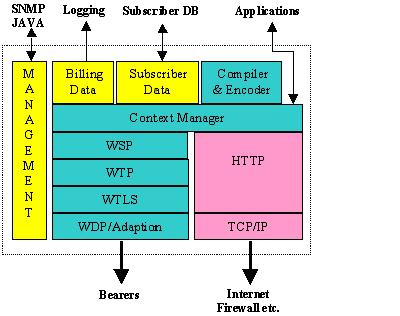 |
| Fig.8: Architecture of the WAP Gateway |
WDP
The WAP datagram protocol (WDP) is the transport layer that sends and receives messages via any available bearer network, including SMS, USSD, CSD, CDPD, IS-136 packet data, and GPRS.
WTLS
Wireless transport layer security (WTLS), an optional security layer, has encryption facilities that provide the secure transport service required by many applications, such as e-commerce.
WTP
The WAP transaction protocol (WTP) layer provides transaction support, adding reliability to the datagram service provided by WDP.
WSP
The WAP session protocol (WSP) layer provides a lightweight session layer to allow efficient exchange of data between applications.
HTTP Interface
The HTTP interface serves to retrieve WAP content from the Internet requested by the mobile device.
(V) i-Mode
i-mode is a WAP-like mobile internet service originating in Japan introduced by NTTDoCoMo (Nippon Telephone and Telegraph DoCoMo - doco mo means "anyplace you go" in Japanese and the acronym stands for "Do Communication Over the Mobile Network."). This was invented by Mari Matsunga and was lunched in February, 1999.
The markup language used for i-mode is Compact HTML or cHTML. cHTML is a subset of HTML that leaves out coding for JPEG images, tables, image map, multiple character fonts and styles, background color or images, frames, and cascading style sheets. These things are excluded due to the low bandwidth and limited screen-size of cellphones. The internet connection of i-mode is always on.
i-mode allow users to do their e-mail and text messaging. Users can also view news and horoscopes, and download ring tones, cartoon characters and train times. Users can connect to any site that supports cHTML approved by NTTDoCoMo.
What are the differences between i-mode and WAP?
The biggest difference of WAP and i-Mode is certainly the always-on technology which makes i-Mode so popular. In contrary to WAP, i-Mode phone is always connected to the internet and the user only pays for the amount of data downloaded. So far, with the GSM networks, this is not the case for WAP. GPRS is also always on.
Currently, i-Mode is the user-friendlier technology. Another feature which WAP doesn't have is the 256 colour capability of some i-Mode devices, which makes the whole appearance look much better and attractive. i-Mode screens also use many graphics to make the navigation for the user easier.
The transmission rates of i-Mode are just about the same as for WAP but since the service is always-on, it saves all the dial-up time.
WAP and i-Mode are both capable of sending and receiving e-mail. In this category, WAP is ahead, because i-Mode e-mail is restricted to 500 bytes.
At this time, if one compares the 2 technologies, i-Mode is the clear winner of the contest.
Voice infrastructure
Mobile networks are relatively new; all switching is digital, and all mobile phones use tone dialing, which represents digits by musical notes.
Station controllers
The first step in a digital cell phone network is the link from the BTS to the Base Station Controller (BSC). This simply converts signals from a base station to a more landline- friendly format. Analog networks need to place the BSC at the BTS itself so that analog radio waves can be converted to digital signals as soon as they are received. Digital networks prefer to locate it a little away, which keeps costs down because it allows several base stations to share the BSC.
Switching Centers
The most complex component in a mobile voice network is the Mobile Switching center( MSC). Analogous to a telephone exchange, the MSC is responsible for keeping track of users and sending them calls when necessary. A network usually contains many MSCs, each of which is responsible for several clusters of cells.
Each MSC is linked to several databases, which are used to keep track of users' locations. These can be stored on a computer at the MSC network.
Trunking
In the early cellular networks, all MSCs were meshed-each was connected to each other. This quickly grew uncontrollably, Trunking Switching Centers ( TSCs) became common. These simply aggregate connections from several MSCs and combine them in very high-capacity cable.
Gateways
The Gateway Mobile Swithching center (GMSC) sits at the top of the switching hierarchy. It connects a mobile network to the fixed telephone network (the PSTN) and to other operators with which it has roaming agreements. One of its most important roles is to translate the protocol cellular system's own signalling protocols to Signaling System (SS7), the protocol which regular telephone lines use to carry information such as phone numbers
Mobile video telephony is frequently seen as a future strategy - something that will become significant once 3G networks are widely deployed. Video offers, including live video calling, are becoming available on newly deployed 3G networks in Japan, Korea and portions of Europe.
Video clips can easily be included in the range of content available for download. Even on a GPRS network, sending or downloading a five-to-15-second video clip can be completed within 30 to 40 seconds. Multimedia handsets are available, from all major handset vendors.
As MMS (multimedia messaging service) is deployed, video can be included in the range of MMS options. Alternately, e-mail can be used to pass video messages. Again, five-to-15-second video clips are typical with MMS or e-mail, but there is also the option of subscriber-generated content. In other words, just as subscribers use camera phones to take pictures, mobile video handsets allow users to record short video clips. There are interoperable handsets with compatible video capabilities and interconnection for exchanging video messages.
Evolution
There are four video capabilities that support a wide range of video applications. Video download and video messaging using MMS or e-mail are the first; video streaming and live video calling follow.
Video streaming is possible on 2.5G networks, although data rates of 30 kbps to 40 kbps limit content to relatively low resolution and low frame rates. However, this may be adequate for connecting to surveillance cameras in the home or elsewhere. 3G networks support high-performance video streaming, up to and including live TV. The advantage of video streaming is the ability to support arbitrarily long video programs not just 10-second clips. This expands the range of applications to serious news, extended sports coverage, celebrity interviews and so on.
Of course, if the goal is actual broadcast TV, it is more efficient to use broadcast technology than precious mobile phone bandwidth. Combined handsets are now available in Japan that support both 2.5G/3G telephony and broadcast TV reception. Examples are the NEC V601N and the Toshiba V401T.
The ultimate video service is live video calling, video telephony. This requires 3G data rates and a low-latency QoS guarantee. These services are based on the 3G-324M standard. 3G-324M video services get the required QoS by using circuit-switched data, typically at 64 kbps.
Video Applications
The broader view of mobile video includes the range of applications being deployed, tested or proposed, Video on demand and video news alerts. The success of ring tones and logos has led to video phone personalization. There are also video quizzes and games.
Mobile video telephony (two-party calling) has moved beyond trials to widespread day-to-day service. For instance, in Japan, NTT DoCoMo's FOMA (Freedom of Mobile Multimedia Access) service handsets are capable of live video calling.
While the picture quality of this mobile video telephony service is not as great as that of high-end room conferencing systems, mobile video handsets have other advantages. First, they are easy to operate - video and voice work the same way. Second, they are personal and mobile, so there are personal applications that would never appear with a room conferencing system. Business uses include showing field conditions to associates back at the home office.
Although 3G services and high-performance mobile-video applications are in their nascence, the surprise factor is clear. The trend can not be ignored. Fortunately, many video applications can be supported with mobile network.
Mobile communications is more than just a convenience. The evolution of Mobile communication networks obviously has led to innovative technology advancement for instance in mobile service delivery.
Fortunately, the full potential of all the benefits of mobile services we associate with the World Wide Web today - multimedia, e-commerce, unified messaging and peer-to-peer networking will be fulfilled in the future - 4G (Fourth Generation).
4G mobile communications will be based on IP transport, ubiquity and diversity. Open, global and ubiquitous communications make people free from spatial and temporal constraints. Versatile communication systems will also be required to realize customized services based on diverse individual needs. The flexibility of mobile (Information Technology) IT can satisfy these demands simultaneously. Therefore, mobile IT can be seen to play a key fundamental role in the 21st century.
A. El-Rabbany, Introduction to GPS : the global positioning system, ISBN 1-58053-183-0, Artech House, 2002
D. Wisely, P. Eardley, L. Burness, IP for 3G Networking Technology for mobile Communication, ISBN 0-471-48697-3, John Wiley & Sons, 2002.
S. NANDA , D.J. GOODMAN, Third generation wireless information networks, ISBN 0-7923-9218-3, Kluwer Academic Pub., 1992
U. Black, Second generation mobile and wireless networks, ISBN 0-13-621277-8, Prentice Hall PTR, 1999